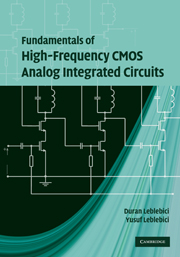Book contents
- Frontmatter
- Contents
- Preface
- 1 Components of analog CMOS ICs
- 2 Basic MOS amplifiers: DC and low-frequency behavior
- 3 High-frequency behavior of basic amplifiers
- 4 Frequency-selective RF circuits
- 5 L-C oscillators
- 6 Analog–digital interface and system-level design considerations
- Appendix A Mobility degradation due to the transversal field
- Appendix B Characteristic curves and parameters of AMS 0.35 micron NMOS and PMOS transistors
- Appendix C BSIM3-v3 parameters of AMS 0.35 micron NMOS and PMOS transistors
- Appendix D Current sources and current mirrors
- References
- Index
Preface
Published online by Cambridge University Press: 05 June 2012
- Frontmatter
- Contents
- Preface
- 1 Components of analog CMOS ICs
- 2 Basic MOS amplifiers: DC and low-frequency behavior
- 3 High-frequency behavior of basic amplifiers
- 4 Frequency-selective RF circuits
- 5 L-C oscillators
- 6 Analog–digital interface and system-level design considerations
- Appendix A Mobility degradation due to the transversal field
- Appendix B Characteristic curves and parameters of AMS 0.35 micron NMOS and PMOS transistors
- Appendix C BSIM3-v3 parameters of AMS 0.35 micron NMOS and PMOS transistors
- Appendix D Current sources and current mirrors
- References
- Index
Summary
In the first half of the twentieth century the radio was the main activity area of the electronics industry and, correspondingly, RF circuits occupied a considerable part in the electronic engineering curriculum and books published in this period. Properties of resonance circuits and electronic circuits using them, single-tuned amplifiers as the input stages of receivers, double-tuned circuits as IF amplifiers, RF sinusoidal oscillators and high-power class-C amplifiers have been investigated in depth. It must be kept in mind that the upper limit of the radio frequencies of those days was several tens of MHz, the inductors used in tuned circuits were air-core or ferrite-core coils with inductance values in the micro-henries to milli-henries range, having considerably high quality factors, ranging from 100 to 1000, and the tuning capacitors were practically lossless.
The knowledge developed for the vacuum-tube circuits easily adapted to the transistors with some modifications related to the differences of the input and output resistances of the devices. In the meantime, the upper limit of the frequency increased to about 100 MHz for FM radio and to hundreds of MHz for UHF-TV. The values of the inductors used in these circuits correspondingly decreased to hundreds to tens of nano-henries. But these inductors were still wound, high-Q discrete components.
In the second half of the twentieth century, the emergence of integrated circuits drastically increased the reach of electronic engineering.
Information
- Type
- Chapter
- Information
- Publisher: Cambridge University PressPrint publication year: 2009
